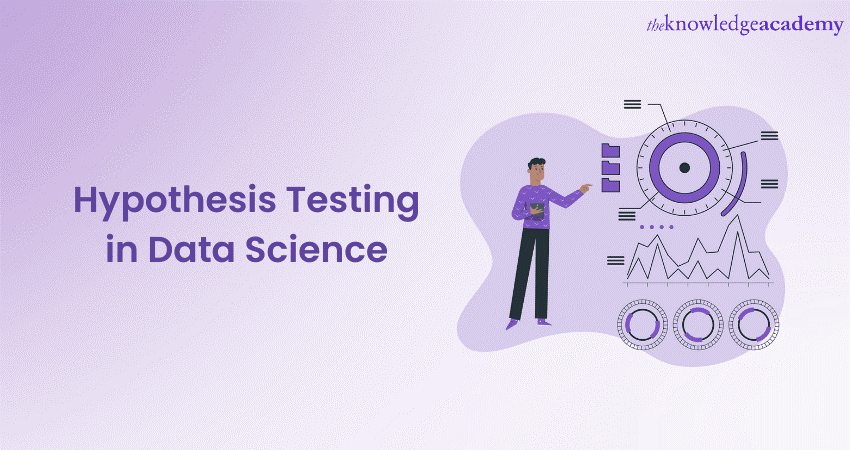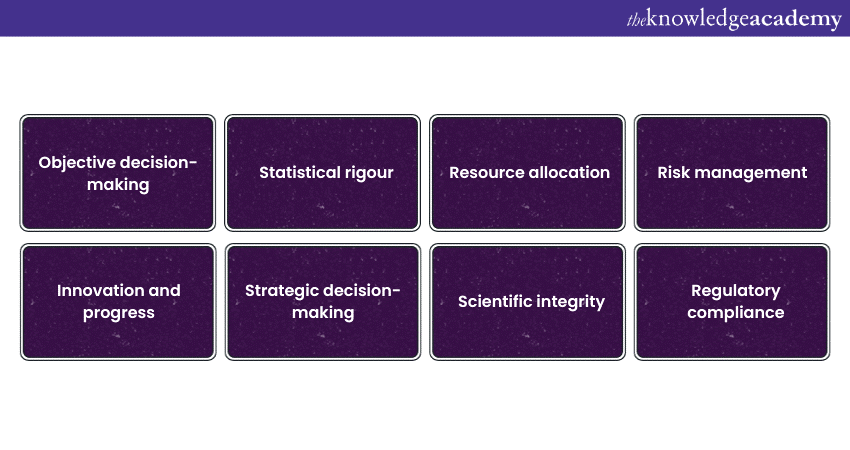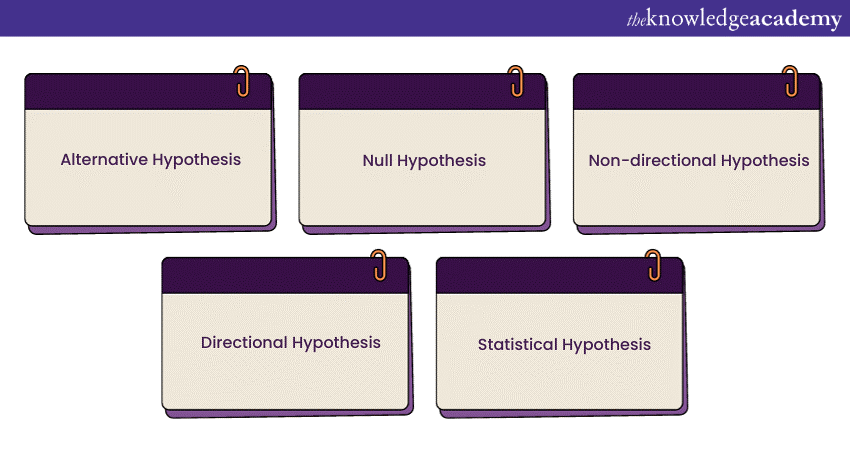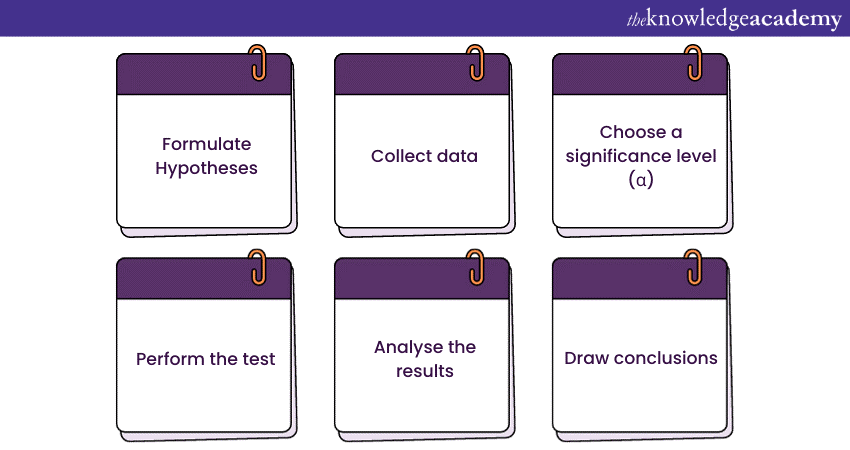We may not have the course you’re looking for. If you enquire or give us a call on 01344203999 and speak to our training experts, we may still be able to help with your training requirements.
We ensure quality, budget-alignment, and timely delivery by our expert instructors.

How can you ensure the reliability of data-driven decisions in an environment riddled with misinformation? The answer lies in the Hypothesis Testing! Hypothesis testing is among the most significant topics in the field of data science. It helps Data Scientists analyse whether the observed effect is statistically correct or merely coincidental through a set of scientific and data-centred tests. This blog will delve deeper into what exactly Hypothesis Testing in Data Science is to help you understand its importance, types, steps to follow, and real-world use cases. Let’s embark on this data-embedded journey!
Table of Contents
1) What is Hypothesis Testing in Data Science?
2) Importance of Hypothesis Testing in Data Science
3) Types of Hypothesis Testing
4) Basic Steps in Hypothesis Testing
5) Real-world Use Cases of hypothesis Testing
6) Conclusion
What is Hypothesis Testing in Data Science?
Hypothesis Testing in Data Science is a statistical method used to assess the legitimacy of assumptions or claims made on the population on the basis of sample data. It involves formulating two Hypotheses, the Null Hypothesis (H0) and the alternative Hypothesis (H1, which can be termed antonyms to the Null Hypothesis), and then using the applications of statistical tests to find out if there is enough credible evidence to support the Alternative Hypothesis.
For instance, you want to analyse whether plant food is effective. On the one hand, you assume that the plant will grow with that other food (termed as an alternative Hypothesis); on the other hand, you say that the plant will not grow (that’s a Null Hypothesis). So, to test the validity of the claims made, you perform specific scientific experiments and tests like adding that plant food into the soil for a few weeks to see if the plant grows.
In other words, Hypothesis Testing helps evaluate the significance of observed effects or differences and draw meaningful inferences from data. This allows Data Scientists to discover patterns, relationships, and insights in fields ranging from medicine to business and beyond.

Importance of Hypothesis Testing in Data Science
Hypothesis Testing in Data Science serves as the cornerstone of scientifical, data-driven decision-making. By systematically testing Hypotheses, Data Scientists can perform several tasks. Below, we have illustrated the importance of Hypothesis Testing.

1) Objective Decision-making
Hypothesis Testing provides a structured and impartial method for data professionals to make evidence-backed decisions based on efficient data analysis. In addition, in the uncertainties of biases-skewed results, Data Scientists predominantly use this method to make sure that their conclusions are grounded in empirical evidence, making their decisions more objective and trustworthy.
2) Statistical Rigour
Data Scientists deal with large datasets and Hypothesis Testing helps them make meaningful sense of them. It quantifies the significance of observed patterns, differences, or relationships. This statistical rigour is critical for determining the differences between mere coincidences and meaningful findings, thus reducing the possibility of making decisions based on random chance.
3) Resource Allocation
Resources, irrespective of whether they are financial, human, or time-related, are often limited. Hypothesis Testing enables Data Scientists to allocate resources efficiently by allowing them to develop statistical strategies or interventions. This ensures that efforts are directed where they are most likely to yield valuable and meaningful results.
4) Risk Management
In domains including healthcare and finance, where you cannot determine the lives and livelihoods, Hypothesis Testing serves as an integral tool for risk assessment. For instance, in drug development, Hypothesis Testing can ascertain the safety and efficiency of new treatments, helping mitigate potential risks to patients.
5) Innovation and Progress
Hypothesis Testing promotes innovation by providing a systematic framework to evaluate and frame newer ideas, products, and strategies. It encourages continual experimentation, feedback, and improvement, ultimately driving continuous progress and innovation.
6) Strategic Decision-making
Organisations formulate their strategies based on data-driven insights. Hypothesis Testing enables them to make informed decisions about market trends, customer behaviour, and product development. These decisions have a foundational basis in empirical evidence, which increases the likelihood of success.
7) Scientific Integrity
In scientific research, Hypothesis Testing is integral to maintaining the integrity of research findings. It ensures accurate conclusions are drawn from rigorous statistical analysis rather than supposition. This robustness is essential for advancing knowledge and on the basis of the existing research.
8) Regulatory Compliance
Several industries ranging from pharmaceuticals to aviation, work under strict regulatory frameworks. Hypothesis Testing helps them to ensure those frameworks comply with the necessary safety and quality standards.
Master Probability for Data Science with our Probability and Statistics for Data Science Training – join now!
Types of Hypothesis Testing
There are several types of Hypothesis Testing, such as null, alternative, one-tailed, and two-tailed tests. These types are described as follows:

1) Alternative Hypothesis
The Alternative Hypothesis, denoted as Ha or H1, is the assertion or claim that researchers make to support their data analysis. The main goal of the Alternative Hypothesis is to suggest that there is a significant effect, relationship, or difference in the population. To put it in simpler words, it's the statement that researchers hope to find evidence for during their analysis. For example, if you are testing a new drug's efficacy, the Alternative Hypothesis might state that the drug has a measurable positive effect on patients' health.
2) Null Hypothesis
The Null Hypothesis, denoted as H0, is the standardised assumption in Hypothesis Testing. It defines that there is no significant effect, relationship, or difference in the observing population. In other words, it represents the status quo or the absence of an effect. Researchers typically collect and analyse enough data to challenge or disapprove of the Null Hypothesis. Considering the drug efficacy example again, the Null Hypothesis might state that the new drug has no effect on patients' health.
3) Non-directional Hypothesis
A Non-directional Hypothesis, also known as a two-tailed Hypothesis, is used when researchers are interested to know if there is any significant difference, effect, or relationship without taking into account its direction of impact (positive or negative). This type of Hypothesis allows the possibility of finding impacts in bi-directions (both positive and negative sides). For instance, in a study comparing the performance of two groups, a Non-directional Hypothesis would suggest that there is a significant difference between the groups without specifying which group performs better.
4) Directional Hypothesis
A Directional Hypothesis, also called a one-tailed Hypothesis, is employed when researchers have a specific expectation about the direction of the impact, relationship, or difference they are investigating. In this case, the Hypothesis predicts an outcome in a particular direction—either positive or negative. For example, if you expect a new teaching method to improve student test scores, a directional Hypothesis will state that the new method leads to higher test scores.
5) Statistical Hypothesis
A Statistical Hypothesis is a specific statement about a population parameter made on the basis of the statistical-based tests. It involves specific numerical values or parameters that can be measured or compared. Such types of hypotheses are crucial for quantitative research and often include means, proportions, variances, correlations, or other measurable quantities. As a result, they provide a precise framework for conducting statistical tests and drawing inferences based on data analysis.
Sharpen your Predictive Modeling techniques with our Predictive Analytics Course- register today!
Basic Steps in Hypothesis Testing
Hypothesis Testing is a critical tool in Data Science, research, and several other fields where data analysis is employed. The following are the basic steps involved in Hypothesis Testing:

1) Formulate Hypotheses
The first step in Hypothesis Testing is to clearly define your research question and convert it into two mutually exclusive Hypotheses:
a) Null Hypothesis (H0): This is the default assumption, often representing the status quo or the absence of an effect. It states that there is no significant difference, relationship, or effect in the population.
b) Alternative Hypothesis (Ha or H1): This is the statement that contradicts the null Hypothesis. It suggests that there is a significant difference, relationship, or effect in the population.
This Hypotheses formulation is crucial, as they serve as the foundation for your entire Hypothesis Testing process.
2) Collect Data
The next step is to gather relevant data by performing various types of surveys, experiments, observations, or any other related methods. You must ensure that the sample data collected should be represent the entire population where you are studying.
3) Choose a Significance Level (α)
Before conducting the statistical test, you need to assess the significance level, which is denoted as ‘α’. The significance level represents the threshold for statistical significance and ascertains your confidence in your results. A common choice is α = 0.05, which implies a 5% risk of making a Type I error (rejecting the Null Hypothesis when it's true). You can choose a different ‘α’ value based on the specific requirements of your analysis.
4) Perform the Test
Based on your formulated data and Hypotheses, select the appropriate statistical test. To this, there are various tests available, including t-tests, chi-squared tests, ANOVA, Regression Analysis, and more. You need to ensure the chosen test aligns with the data type (e.g., continuous or categorical) and the research question (e.g., comparing means or testing for independence).
Execute the selected statistical test on your data to obtain test statistics and p-values. The test statistics quantify your investigating difference or effect, while the p-value represents the probability of obtaining the observed results if the null Hypothesis were true.
5) Analyse the Results
Once you have the test statistics and p-value, it's time to interpret the results. The primary focus in this case is on the p-value:
a) If the p-value is less than or equal to your chosen significance level (α), typically 0.05, you have evidence to reject the null Hypothesis. This shows that there is a significant difference, relationship, or effect in the population to support the alternative Hypothesis.
b) If the p-value is more than α, you fail to reject the null Hypothesis. This shows that there is insufficient evidence to support the alternative Hypothesis.
6) Draw Conclusions
Based on the analysis of the p-value and comparing it with the significance level (α), you can draw conclusions about your research question:
a) In case you reject the null Hypothesis, you can accept the alternative Hypothesis and make inferences based on the evidence provided by your data.
b) In case you fail to reject the null Hypothesis, do not accept the alternative Hypothesis, and you acknowledge that there is no significant evidence to support your claim.
Download the Data Science Cheat Sheet and enhance your coding efficiency today!
Real-world Use Cases of Hypothesis Testing
Hypothesis testing is a crucial facet of reducing the uncertainty of our lives. The following are some of the real-world use cases of Hypothesis Testing.
a) Medical Research: Hypothesis Testing is crucial for medical researchers to analyse the efficacy of new medications or treatments. For instance, researchers use Hypothesis Testing in a clinical trial to assess whether a new drug is more effective than a placebo in treating a particular condition or not.
b) Marketing and Advertising: Businesses use Hypothesis Testing to evaluate the effectiveness of marketing campaigns. A company may test whether a new advertising strategy can lead to a significant increase in sales compared to the previous approach.
c) Manufacturing and Quality Control: Manufacturing industries use the application of Hypothesis Testing to ensure the optimum quality of their products. For example, in the automotive industry, Hypothesis Testing can be applied to test to assess whether a new manufacturing process can reduce the arising defects in an automobile engine.
d) Education: In the field of education, Hypothesis Testing can be used to assess the effectiveness of teaching methods. Researchers may test whether a new teaching approach can lead to statistically significant improvements in student performance.
e) Finance and Investment: Investment strategies are often evaluated using Hypothesis Testing. Investors may need to test whether a new investment strategy outperforms a benchmark index over a specified period.
Discover patterns with advanced algorithms- join our Data Mining Training today!
Conclusion
We hope you understand Hypothesis Testing in Data Science. Hypothesis Testing is a powerful tool that enables Data Scientists to make evidence-based decisions and draw meaningful conclusions and valuable inferences from larger datasets. Understanding its types, methods, and steps involved in Hypothesis Testing is crucial for any Data Scientist to make transparent and data-driven decisions based on scientific evidence. By tactically applying Hypothesis Testing techniques mentioned in this blog, you can gain valuable insights and drive informed decision-making in numerous domains, ranging from technology and finance to the medical industry.
Build robust models with R Techniques with our Decision Tree Modeling Using R Training - join now!
Frequently Asked Questions
How Can I Calculate the Sample Size for Hypothesis Testing?

To calculate the sample size for Hypothesis Testing, you need to assess the effect size, significance level (α), power (1 - β), and variability (standard deviation). Then, by applying the sample size formulas that align with your test (e.g., t-test), you can find the exact sample size to simplify your data analytics.
What Should I Do If the Assumptions Are Violated?

If Hypothesis Testing assumptions are violated, you should try to transform your data using non-parametric tests or applying several robust statistical methods. Otherwise, you can increase the sample size for accurate solutions. Moreover, it's important to determine which specific assumptions are violated to select the most appropriate method.
What are the Other Resources and Offers Provided by The Knowledge Academy?

The Knowledge Academy takes global learning to new heights, offering over 3,000 online courses across 490+ locations in 190+ countries. This expansive reach ensures accessibility and convenience for learners worldwide.
Alongside our diverse Online Course Catalogue, encompassing 19 major categories, we go the extra mile by providing a plethora of free educational Online Resources like News updates, Blogs, videos, webinars, and interview questions. Tailoring learning experiences further, professionals can maximise value with customisable Course Bundles of TKA.
What is The Knowledge Pass, and How Does it Work?

The Knowledge Academy’s Knowledge Pass, a prepaid voucher, adds another layer of flexibility, allowing course bookings over a 12-month period. Join us on a journey where education knows no bounds.
What are the Related Courses and Blogs Provided by The Knowledge Academy?

The Knowledge Academy offers various Data Science Courses, including Probability and Statistics for Data Science Training, Predictive Analytics Course, and Advanced Data Science Certification. These courses cater to different skill levels, providing comprehensive insights into All You Need to Know about Statistical Analysis in Data Science.
Our Data, Analytics & AI Blogs cover a range of topics related to Data Science and machine learning, offering valuable resources, best practices, and industry insights. Whether you are a beginner or looking to advance your analytical and technical skills, The Knowledge Academy's diverse courses and informative blogs have got you covered.
Upcoming Data, Analytics & AI Resources Batches & Dates
Date
 Data Science Analytics
Data Science Analytics
Fri 25th Apr 2025
Fri 20th Jun 2025
Fri 22nd Aug 2025
Fri 17th Oct 2025
Fri 19th Dec 2025






 Top Rated Course
Top Rated Course


 If you wish to make any changes to your course, please
If you wish to make any changes to your course, please


